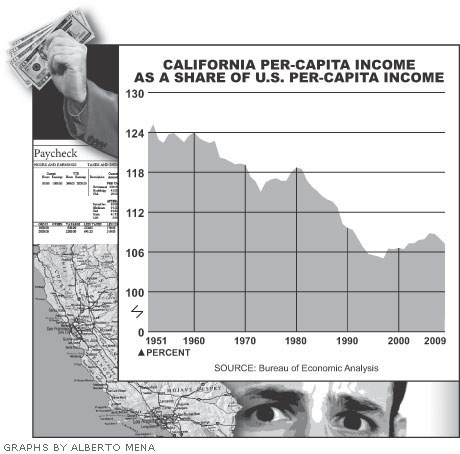Cross-posted on NewGeography.com
California has long been a destination for those seeking a better place to live. For most of its history, the state enacted sensible policies that created one of the wealthiest and most innovative economies in human history. California realized the American dream but better, fostering a huge middle class that, for the most part, owned their homes, sent their kids to public schools, and found meaningful work connected to the state’s amazingly diverse, innovative economy.
Recently, though, the dream has been evaporating. Between 2003 and 2007, California state and local government spending grew 31 percent, even as the state’s population grew just 5 percent. The overall tax burden as a percentage of state income, once middling among the states, has risen to the sixth-highest in the nation, says the Tax Foundation. Since 1990, according to an analysis by California Lutheran University, the state’s share of overall U.S. employment has dropped a remarkable 10 percent.
When the state economy has done well, it has usually been the result of asset inflation-first during the dot-com bubble of the late 1990s, and then during the housing boom, which was responsible for nearly half of all jobs created earlier in this decade.
Since the financial crisis began in 2008, the state has fared even worse. Last year, California personal income fell 2.5 percent, the first such fall since the Great Depression and well below the 1.7 percent drop for the rest of the country. Unemployment may be starting to ebb nationwide, but not in California, where it approaches 13 percent, among the highest rates in the nation. Between 2008 and 2009, not one of California’s biggest cities outperformed such traditional laggards as New York, Pittsburgh, and Philadelphia in employment growth, and four cities-Los Angeles, Oakland, Santa Ana, and San Bernardino-Riverside-sit very close to the bottom among the nation’s largest metro areas, just slightly ahead of basket cases like Detroit. Long a global exemplar, California is in danger of becoming, as historian Kevin Starr has warned, a "failed state."
What went so wrong? The answer lies in a change in the nature of progressive politics in California. During the second half of the twentieth century, the state shifted from an older progressivism, which emphasized infrastructure investment and business growth, to a newer version, which views the private sector much the way the Huns viewed a city-as something to be sacked and plundered. The result is two separate California realities: a lucrative one for the wealthy and for government workers, who are largely insulated from economic decline; and a grim one for the private-sector middle and working classes, who are fleeing the state.

The old progressivism began in the early 1900s and lasted for half a century. It was a nonpartisan and largely middle-class movement that emphasized fostering economic growth-the progressives themselves tended to have business backgrounds-and building infrastructure, such as the Los Angeles Aqueduct and the Hetch Hetchy Reservoir. One powerful progressive was Republican Earl Warren, who governed the state between 1943 and 1953 and spent much of the prospering state’s surplus tax revenue on roads, mental health facilities, and schools. Another was Edmund G. "Pat" Brown, elected in 1958, who oversaw an aggressive program of public works, a rapid expansion of higher education, and the massive California Water Project.
But by the mid-1960s, as I noted in an essay in The American two years ago, Brown’s traditional progressivism was being destabilized by forces that would eventually transform liberal politics around the nation: public-sector workers, liberal lobbying organizations, and minorities, which demanded more and more social spending. This spending irritated the business interests that had formerly seen government as their friend, contributing to Brown’s defeat in 1966 by Ronald Reagan. Reagan was far more budget-conscious than Brown had been, and large declines in infrastructure spending occurred on his watch, mostly to meet a major budget deficit.
The decline of progressivism continued under the next governor: Pat Brown’s son, Edmund G. "Jerry" Brown, Jr., who took office in 1975. Brown scuttled infrastructure spending, in large part because of his opposition to growth and concern for the environment. Encouraged by "reforms" backed by Brown-such as the 1978 Dill Act, which legalized collective bargaining for them-the public-employee unions became the best-organized political force in California and currently dominate Democrats in the legislature (see "The Beholden State," Spring 2010). According to the unions, public funds should be spent on inflating workers’ salaries and pensions-or else on expanding social services, often provided by public employees-and not on infrastructure or higher education, which is why Brown famously opposed new freeway construction and water projects and even tried to rein in the state’s university system.
The power of the public-employee lobby would come to haunt the recall-shortened gubernatorial reign of Gray Davis, Brown’s former chief of staff. The government workers’ growing demands on the budget, green groups’ opposition to expanding physical infrastructure, and Republican opposition to tax increases made it impossible for either Davis or his successor, Arnold Schwarzenegger, to expand the state’s infrastructure at a scale necessary to accommodate its growing population.
The new progressives were as unenthusiastic about welcoming business as about building infrastructure. Fundamentally indifferent or even hostile to the existing private sector, they embraced two peculiar notions about what could sustain California’s economy in its place. The first of these was California’s inherent creativity-a delusion held not only by liberal Democrats. David Crane, Governor Schwarzenegger’s top economic advisor, once told me that California could easily afford to give up blue-collar jobs in warehousing, manufacturing, or even business services because the state’s vaunted "creative economy" would find ways to replace the lost employment and income. California would always come out ahead, he said, because it represented "ground zero for creative destruction."
Originally published in The City Journal

